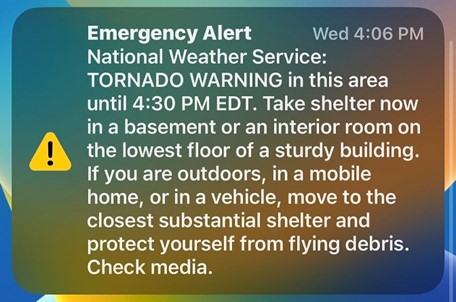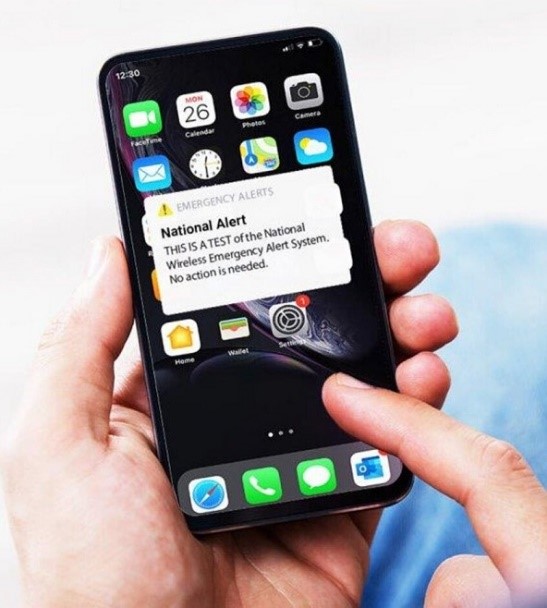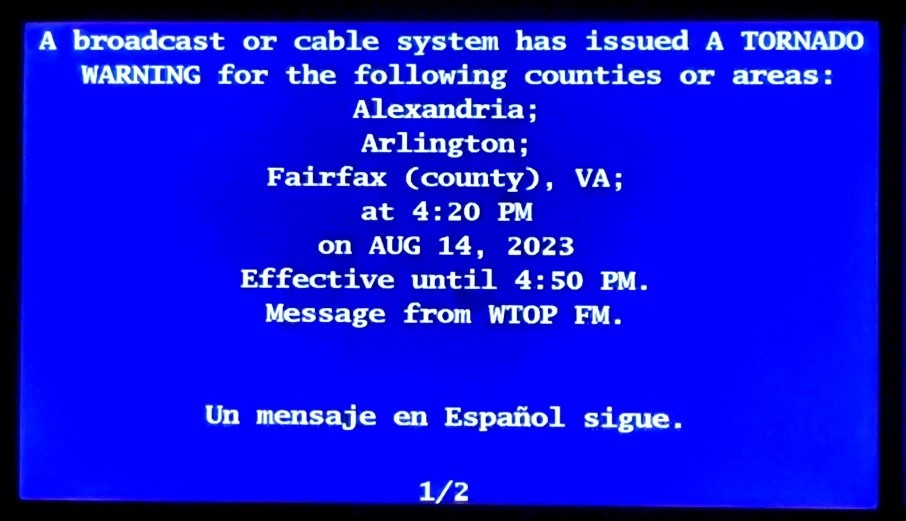The Integrated Public Alert and Warning System (IPAWS) is FEMA's national system for local alerting that provides authenticated emergency and life-saving information to the public through mobile phones using Wireless Emergency Alerts (WEA), to radio and television via the Emergency Alert System (EAS), on the National Oceanic and Atmospheric Administration's NOAA Weather Radio, and to digital devices and services via the IPAWS All-Hazards Information Feed.
Myths and Facts
Myth: WEA uses your cellular data and increases your phone bill.

WEA does not use customer cellular data and does not affect phone bills. WEA is not a text message, email or phone call. An example of a Tornado Warning WEA is pictured to the left.
Myth: WEA and EAS sounds will activate vaccines, nanoparticles and graphene oxide.
The audio attention signal used in WEA and EAS contains the same tones that have been used since 1963 in the Emergency Broadcast System. The tones are established in federal law (47 C.F.R. 10.520). FEMA is not aware of any health effects caused by the audio signal.
Myth: If I do not reply to an alert, my phone will be inoperable. If I do reply, it will tell the government who and where I am.
WEA cannot make your phone inoperable. It uses broadcast technology and cannot gather information about you or your device or track your location.
It is not possible to reply to a WEA alert. Some alerts may contain links to websites with more information. Use of the links is optional.
Myth: To receive WEA alerts requires a paid mobile phone account.
WEA alerts are not sent to individual phones. Phones that are turned on, but without an active account or subscriber SIM card can still receive alerts.
Myth: WEA installs malware on my phone. I can pay a technician to remove WEA from my phone.
Beware of scams. WEA does not install anything on phones.
Myth: It is impossible to prevent or opt-out of alerts on my phone.

You can opt-out of most WEA alerts in your phone settings. By law it is not possible to opt-out of National Alerts. No emergency National Alert has ever been sent; only tests. An example national test appears on the left.
Myth: IPAWS failed because I did not receive an alert or test when others did.
Alerts may arrive at different times depending on your location or wireless provider. You may have opted-out of some alerts. Your phone may be in airplane mode or not connected to your wireless provider.
Myth: If I send FEMA my phone number, they can find out why I am not receiving WEA alerts.
WEA does not use phone numbers. FEMA has no information on the performance of any individual phone.
Myth: Public-safety officials do not practice sending emergency alerts.
FEMA requires officials to practice sending alerts every month. They must compose demonstration alerts and send them to FEMA. This monthly procedure does not send alerts to the public. It reinforces the skills and readiness of persons entrusted with access to IPAWS.
Myth: IPAWS can only be used for life-threatening national emergencies.
FEMA does not place limitations or restrictions on criteria for Alerting Authorities to issue public alerts. FEMA does not monitor, review, modify, approve, or disapprove the content of alerts sent by public-safety officials.
Myth: IPAWS failed because my TV or radio did not receive an alert or a test.
Broadcasting of Emergency Alert System (EAS) alerts by radio and TV stations is voluntary, except for certain EAS tests and National Alerts. No emergency National Alert has ever been sent, only tests. EAS tests are often broadcast overnight when most Americans are not using TV or radio. Streaming services are not required to present EAS alerts or tests.
Myth: IPAWS failed because the test was only electronic noises and no announcements.
Some tests contain only data with no speech.
Myth: Studies show that AMBER Alerts sent by WEA have not led to the recovery of abducted children.
As of December 31, 2023, AMBER Alerts sent by WEA led to the safe recovery of 165 children, according to the U.S. Department of Justice, which funds the AMBER Alert program.
Myth: You must turn Test Alerts ON in your phone to receive alerts.
The Test Alerts setting in your phone has no effect on receiving actual WEA alerts. All mobile phones sold in the U.S. have the test setting off as shipped from the factory.
Alerting Authorities use Test Alerts for technical evaluation of their systems. Most phone subscribers have no need to turn this setting on.
Myth: U.S. officials refused to send a WEA alert on September 11, 2001.
WEA did not exist until 2012.
Myth: Former President Trump invented the EAS.
The Federal Communications Commission established the EAS in 1994, as the successor to the Emergency Broadcast System created in 1963.
Myth: You must sign up to receive WEA alerts.
No sign-up, account, or subscription is needed to receive WEA alerts. Some local governments have their own mass-notification systems that require sign-up.
Myth: EAS tests on TV are timed to interrupt sports, movies, or political shows.
EAS tests are scheduled one year in advance by each State Emergency Communications Committee. Half of these tests are broadcast at night and half in the daytime. The brief tests are not timed to interrupt any TV shows.
Actual EAS alerts are emergency messages and are not scheduled in advance. A Tornado Warning EAS alert is shown below.

Myth: Wrapping a mobile phone in tinfoil and placing it in a microwave oven will prevent alert reception.
Turning the phone off or placing it in airplane mode will prevent it from receiving alerts or any other communications. Nothing else is required. Operating an oven containing a phone could cause the phone battery to ignite and explode.


